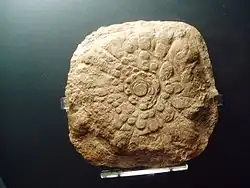Mawsonites
| Mawsonites Temporal range: Ediacaran
| |
|---|---|

| |
| Fossil of Mawsonites spriggi at Natural History Museum, London | |
| Scientific classification | |
| Kingdom: | Animalia |
| Phylum: | incertae sedis |
| Genus: | † Glaessner & Wade, 1966 |
| Type species | |
| Mawsonites spriggi Glaessner & Wade 1966
| |
Mawsonites is a fossil genus dating to the Ediacaran Period, from 635–539 million years ago during the Precambrian era. The type species is Mawsonites spriggi. The names derive from South Australian geologists Douglas Mawson and Reg Sprigg.
Taxonomy
The broader relationships of Mawsonites are as yet undefined. The animals lived during the Ediacaran, from 635–539 million years ago.
The type species is Mawsonites spriggi, named after South Australian geologist Douglas Mawson, and his student at the University of Adelaide, Reg Sprigg, later a notable geologist himself. It was named by Martin Glaessner and Mary Wade in 1966.[1][2][3]
Description
Glaessner and Wade describe it as: "Large, compressed, but in life presumably dome-shaped, becoming steeply conical near centre. Central conical part smooth-walled, truncated, and compressed in curved, overlapping folds in the holotype. The greater part of the surface is strongly sculptured with arcs of prominent, large, irregular, bosses which increase in size out-wards, and merge into the peripheral zone which is dominated by large, irregular, radially elongate lobes separated by deep clefts. They form radial furrows on the outer half of the disc. Periphery lobate. A circular area bearing the conical centre and the enclosing one or two arcs of bosses was more compressible than the remainder of the bell and was enclosed by a shallow annular groove on the surface of the dome."[4][1]
Sprigg had labelled the fossil in 1958 as "Unnamed jellyfish".[1] Mawsonites has been theorised to represent algae holdfasts, jellyfish,[5] a filter feeder, a burrow, a microbial colony, or invertebrate tracks.[6] Several of these possibilities would indicate that Mawsonites represents a trace fossil, not an organism. Its biological affinities were also called into question amid suggestions that it might represent a mud volcano or other sedimentary structure, but further research showed that these structures could not satisfactorily account for its complexity.[7]
Discovery and significance
The fossil was found in fossil beds discovered in 1946 by Reg Sprigg in the Ediacara Hills, around 30 km (19 mi) west of Beltana in the Flinders Ranges, South Australia.[8][9] The site is now part of Nilpena Ediacara National Park, and part of a bid for World Heritage Site listing[10]
Sprigg's fossils are highly significant, as they represent the first discovery of an assemblage of multicellular biota from rocks of an epoch later called the Ediacaran, derived from the hills where discovered. The Edicaran biota show the earliest stages of animal evolution, which were quite distinct from the later Cambrian fossils.[8]
Examples
Mawsonites spriggii is held in the Sprigg Collection at the South Australian Museum in Adelaide, South Australia.[4][8]
The National Museum of Natural History in Washington, D. C. holds a cast of the fossil.[11][12]
See also
References
- ^ a b c Glaessner, Martin F.; Wade, Mary (1966). "The Late Precambrian Fossils from Ediacara, South Australia" (PDF). Palaeontology. 9 (4): 599–628.
- ^ "Ediacaran Taxa". Peripatus. 22 May 2005. Archived from the original on 12 May 2006. Retrieved 15 August 2025.
- ^ Bain, Andrew (28 January 2024). "Arkaroola's Ridgetop Sleepout experience: Extraordinary new camp boasts wonder in every direction". The Sydney Morning Herald. Retrieved 15 August 2025.
- ^ a b "Mawsonites". www.Ediacaran.org. Retrieved 15 August 2025.
- ^ McMenamin, Mark A. S. (1990). The Emergence of Animals. New York: Columbia Press. p. 19-24. ISBN 0-231-06647-3.
- ^ Walker, Cyril; Ward, David (2002). Fossils (Second American ed.). Dorling Kindersley. p. 43. ISBN 0-7894-8984-8.
- ^ van Loon, A.J. (2008). "The nature of Mawsonites (Ediacara fauna)". Gondwana Research. 14 (1–2): 175–182. Bibcode:2008GondR..14..175V. doi:10.1016/j.gr.2007.08.009.
- ^ a b c "Sprigg Ediacaran Fossil Collection, South Australian Museum-Adelaide Palaeontological Collections". IUGS. 6 August 2024. Retrieved 15 August 2025.
- ^ "Ancient seabed fossils in SA named among top 11 museum collections globally". SA Museum. 1 November 2024. Retrieved 15 August 2025.
- ^ "Flinders Ranges". UNESCO World Heritage Centre. 21 April 2025. Archived from the original on 30 June 2025. Retrieved 13 August 2025.
- ^ "Mawsonites spriggi Glaessner & Wade, 1966". Smithsonian Institution. 17 October 2024. Retrieved 15 August 2025.
- ^ "Paleobiology Collections Search". SI NMNH. Retrieved 15 August 2025.
Further reading
- Paul Willis and Abbie Thomas. Digging Up Deep Time: fossils, dinosaurs and megabeasts from Australia's distant past. ABC Books, 2005. ISBN 0733312608